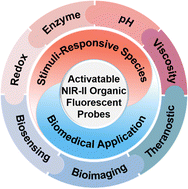Recent advances in activatable NIR-II organic fluorophores for biomedical applications
Abstract
Fluorescence imaging in the second near-infrared region (NIR-II) shows great potentials in intravital imaging and analysis due to its high penetration depth and low photo-damage. However, traditional organic fluorophores usually have inferior emission efficiency and exhibit “always on” signals in the NIR-II region. This leads to high background noise and then severely limits their further applications in vivo. Fortunately, activatable organic fluorescent probes can emit well only in response to some over-expressed specific biomarkers, thus resulting in high signal-to-background ratios (SBRs). At present, activatable organic fluorescent probes in the NIR-II region have gained considerable attention and make significant progress in the biomedical field. Therefore, in this review, we overview the molecular design and stimuli-responsive approach of these reported activatable NIR-II organic fluorophores. This is mainly classified by their various stimuli-responsive species, including redox species, enzymes, pH and also viscosity. Then, their applications in biomedical fields, ranging from biosensing to bioimaging and theranostic platforms, are also highlighted. Based on these results, it is anticipated that this review can help the development of activatable NIR-II organic fluorophores to be well understood, thus providing guidelines in their molecular design and synthesis. This review may also accelerate the further development of new activatable probes that can be used in real-world biomedical applications.

- This article is part of the themed collections: Materials Chemistry Frontiers Emerging Investigator Series 2022–2023, 2023 Materials Chemistry Frontiers Review-type Articles and FOCUS: Recent progress on bioimaging technologies


 Please wait while we load your content...
Please wait while we load your content...